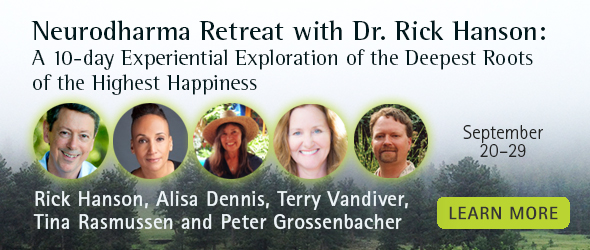Eddies in the Stream
By Dr. Rick Hanson //
1
Rivers flow and eddies form.
An eddy is a relatively stable pattern whose elements continually change. It is “standing-streaming,” a term from Evan Thompson’s marvelous book, Mind in Life.
All eddies disperse eventually.
2
In a river, an eddy depends on many conditions. These include:
- The state of the eddy itself just one moment ago
- The shape of the riverbed, nearby boulders, water flows immediately upstream, and the amount of snowfall last winter. Going back and back, those conditions depend on the history of the earth, the solar system, the universe.
- Countless molecules of water
3
Molecules depend on atoms, such as hydrogen and oxygen.
Almost all atoms heavier than helium depend on the stars which made them, mainly while exploding.
A river is fluid stardust.
A particle of any size is congealed energy.
A river is a flow of light.
4
Atoms depend on subatomic particles made from quarks.
Quarks are made from even smaller entities – perhaps infinitesimal vibrating strings – that comprise the substrate of the physical universe.
The substrate of the universe depends on the conditions present in the Big Bang. Like all the patterns within it, the substrate is conditioned by preceding causes.
This substrate is not well understood. Scientists speak of a “quantum foam” where eddies of matter and energy continually swirl together and disperse. The substrate of our universe seems to be turbulent at every infinitesimally small point.
Nonetheless, at any larger scale and under almost all conditions, the substrate seems to have stable properties. (Exceptions – which won’t be mentioned again – include the changing rate of expansion of the universe, and possibly black holes.) Patterns of matter and energy emerging from the substrate of the universe change continually, but the substrate remains the same.
Eddies are patterns of a river. Similarly, all forms of matter and energy – from quarks to galaxies, from microvolts to lightning bolts – are patterns of the substrate of the universe.
5
Twirling electrons, dancers in a club, friends on the sofa, dishes in the sink, freeway traffic, international coalitions, moons and stars, predators and prey, clouds, bulldozers, breakfast, projects, problems, solutions, a human body, a human life, clusters of galaxies, our own blossoming universe surrounded by mystery . . . All eddies in the stream.
Every eddy is compounded of parts, dependent upon causes, and impermanent.
Clinging to eddies – trying to hold onto pleasant ones, and to struggle with unpleasant ones – is full of tension and frustration, and ultimately futile.
Clinging to eddies is suffering.
6
The substrate of the universe enables an infinite variety of patterns, as a river enables an infinite variety of eddies. Eddies pattern a river momentarily without ever altering its capacity to be patterned. Just so, all patterns of matter and energy emerge, persist, and disperse without ever changing the substrate’s capacity to birth, hold, and release them.
As soon as a pattern forms, its multiple possibilities have converged on a single actuality. The substrate is a space of effectively infinite freedom in which actualities emerge into unfreedom and then disperse.
7
It is always now. The duration of now seems to be infinitesimally minute. Yet somehow it contains the causes from the past that will create the future.
At the leading edge of now, the quantum foam of the substrate is rampant with possibilities. For example, a single particle can exist in two different places at the same time before its location is resolved. Some particles are so entangled that the coalescing nature of the one instantly establishes, faster than the speed of light, the nature of the other.
Just before quantum potentiality coalesces into actuality, the eternally emergent edge of now is as free as anything can ever be.
8
Information is a reduction of uncertainty, a signal against a backdrop of noise.
Information is represented by patterning a suitable substrate. For example, the information of Beethoven’s Ode to Joy can be represented by a musical score on paper, frequency modulations of electromagnetic waves, pulsations in stereo speakers, and patterned firings of neural networks.
The mind, broadly defined, is all the information represented by the nervous system. Most of the mind is forever unconscious. Because “neurons that fire together, wire together,” the movements of the mind through the nervous system shape it like rain on a hillside.
Apart from possible transcendental factors – which are acknowledged, believed in, and bowed to, but outside the frame of this essay – the brain is the necessary and proximally sufficient condition for the mind.
It is only proximally sufficient because the brain depends on the nervous system, the body as a whole, the natural world, evolution, culture, and the mind itself.
Mental activity entails neural activity. When the mind changes, the brain changes. When the brain changes, the mind changes. Therefore, you can use your mind to change your brain to change your mind.
No one yet knows how neural activity becomes conscious mental experience.
9
The brain contains 100 billion neurons making approximately 500 trillion synaptic connections with each other. Neurons typically fire 5-50 times a second. Every second, about a quadrillion synaptic activations occur inside your head.
This activity creates a background of fertile noise that is transiently patterned to form the signals – the information – that comprise the mind.
The number of potential patterns in the brain is bounded by the number of possible combinations of neurons firing or not. That quantity is 10 to the millionth power – one followed by a million zeros. The estimated number of atoms in the universe is one followed by “just” eighty zeros.
The neural substrate can hold an effectively infinite variety of mental patterns.
10
Conscious mental activity seems to be enabled by a neural substrate that is centered in the midline of the brain – including the cingulate, insula, thalamus, and medial prefrontal cortex – with extensions into the upper-outer regions of the prefrontal cortex and down into the brain stem. The contours of this substrate are continually changing as new regions are brought on-line or taken off-line, depending on the information they carry or need to receive.
Conscious mental events include sensations, images, sounds, memories, emotions, and inner language; for simplicity, let’s call these thoughts. A thought depends on a neural pattern: a momentary coalition of millions, sometimes billions of synapses.
A thought is an eddy of information mapped to an eddy of neural activity.
11
For any thought to emerge, there must be unused neural capacity to represent it.
It takes at least 50-100 milliseconds to form the coherent assembly of synapses that underpins a thought. During that window of formation, the underlying substrate of noisy neural activity is fertile with potential.
Once a neural assembly eddies into existence, it is conditioned and unfree. The thought remains what it is, determined, until its synaptic pattern disperses, usually within a second or two. Then those synapses become available for representing new eddies of thought.
Thoughts rise out of and fall back into a field of effectively infinite possibility.
The mind can change neural structure, but it can never change the fundamental capacity of its neural substrate to form the mind.
12
At any moment, there is always some unused neural capacity, firing noisily, quivering to become a signal. Not yet patterned, conditioned, and unfree. Nothing yet manifest.
In meditation, we become increasingly intimate with that neural potentiality. As the signals it carries diminish and become less insistent, whatever may be experienced of that capacity becomes more available to awareness. We abide increasingly as the open space of awareness – abiding increasingly as neural representing rather than as patterns that are represented.
Informational possibility can be sensed directly. Quantum possibility can be intuited through its analogue in informational possibility – and perhaps sensed directly as well.
As contemplative practice deepens – along with virtue and wisdom – we become increasingly aware of and centered in the freedom that exists prior to thought.
Aware of mental/neural eddies emerging and dispersing. None of them a reliable basis for lasting happiness.
Abiding in mental/neural possibility before patterns are pinned to it like notes to a bulletin board.
If there are indeed transcendental influences, the eternal space of possibility at the leading edge of now would be an opportune window for Grace.
13
Eddies of matter and energy, and eddies of thought, have the same nature:
- Changing and impermanent
- Dependent upon preceding causes and conditions; dependent upon their substrate; inextricably intertwined with and dependent upon other eddies. Therefore, in the traditional term, they are “empty” of inherent self-existence.
- Emergent at the leading edge of now
- Fraught with fertile possibility in the instant of their emergence
- Patterns of their substrate that never change the substrate itself
In short, the universe all around you, and your own mind, have the same underlying nature. The stars above, the grass and worms below, and your thoughts of these and any other thing are one in their deep nature.
What would it be like to rest in that nature, emergent moment to moment?
14
This consideration of eddies and the common nature of the substrate of the universe and the substrate of the mind, is relevant to some of the most profound attainments in Buddhism (and perhaps in other contemplative traditions as well).
In the earliest surviving records of the teachings of the Buddha, Nirvana is considered to be a major, even primary, aim of practice. It is described as (In the Buddha’s Words, Bhikkhu Bodhi, 2005):
- the unborn, unaging, unailing, deathless, sorrowless, and undefiled supreme security from bondage (p. 55)
- the stilling of all [mental] formations, the relinquishing of all acquisitions, the destruction of craving, dispassion, cessation (p. 70)
- the destruction of lust, hatred, and delusion (p. 364)
- the unconditioned, uninclined, taintless, truth, far shore, subtle, very difficult to see, stable, undisintegrating, unmanifest, unproliferated, peaceful, sublime, auspicious, secure, destruction of craving, wonderful, amazing, unafflicted, dispassion, purity, freedom, nonattachment, island, shelter, asylum, refuge, and the destination and the path leading to the destination (p. 365)
In the words of Bhikkhu Bodhi: What lies beyond the round of rebirths is an unconditioned state called Nibbana [an early term for Nirvana]. Nibbana transcends the conditioned world, yet it can be attained within conditioned existence, in this very life, and experienced as the extinction of suffering . . . The realization of Nibbana comes with the blossoming of wisdom and brings perfect peace, untarnished happiness, and the stilling of the mind’s compulsive drives. Nibbana is the destruction of thirst, the thirst of craving. It is also the island of safety amid the raging currents of old age, sickness, and death. (p. 183)
On a foundation of virtue and wisdom, how can one train the mind – and thus the brain – to attain Nirvana?
15
The Buddha described one path to Nirvana in terms of a progressive process of contemplative absorption that moves through eight non-ordinary states of consciousness – the “form” and “formless” jhanas – to the indescribable: Nirvana.
Nirvana itself may have no neural correlates. But the states of mind that precede it must.
For example, the mental factors that lead to and support the jhanas are specified in the traditional literature: applied and sustained attention, rapture (or bliss), joy (on a spectrum from happiness to contentment to tranquility), and unification of awareness (the contents of mind at any moment experienced as a single whole). See Buddha’s Brain for plausible speculation about the neural substrate of these positive mental states.
Similarly, one can reasonably theorize about the neural substrates of the eight jhanas – and about the implications of those substrates and their progressive changes in the run up to Nirvana. Here is how the jhanas are described (Bodhi, pp. 397-398):
- The first jhana “is accompanied by thought and examination [sometimes translated as consciously applied and sustained attention], with rapture and happiness.” In the second jhana, thought and examination subside. In the third, rapture fades away. The fourth has “neither-pain-nor-pleasure and . . . equanimity.”
- At this point, the individual sees “form, feeling, perception, volitional formations, and consciousness . . . as impermanent . . . as nonself. He turns his mind away from those states and directs it toward the deathless element” (i.e., Nirvana), and does so again in each of the next four states of consciousness.
- “With the complete transcending of perceptions of forms, with the passing away of perceptions of sensory impingement” the individual “enters upon and dwells within . . . the base of the infinity of space . . . the base of the infinity of consciousness . . . the base of nothingness” . . . the base of neither-perception-nor-nonperception . . . and then cessation, Nirvana.
16
In the progressive emergence of the jhanas, thought, focused attention, pleasure and pain, perception and even non-perception – all gradually disperse.
The heart keeps beating and assemblies continue to form in the deep architecture of the nervous system. But in the neural substrate of awareness, eddies of information swirl apart, along with the neural assemblies that represent them. Signals drop out, stage by stage, leaving only fertile noise. Conditioned, unfree patterns disintegrate.
At the ultimate point, there is nothing conditioned at all. There is only unconditioned mental and neural possibility. Whose nature is the same as unconditioned quantum possibility: always present, infinitely open, ultimately indescribable.
There is only abiding in the common nature of the mind and the universe.
17
When eddies of information begin to gather again in the neural substrate of awareness, there is knowing and conviction.
That the eternal ground of mind and universe is open, fertile, and free. That it neither arises nor passes away.
That eddies do arise. Whether a star, spider, or sorrow. And always pass away again.
That eddies call for an appropriate response, whether awe, carefulness, or compassion. But not craving and clinging, and thus suffering.
That the stream itself is our true ground and refuge.
Abiding in the stream.
About the Author
Rick Hanson, Ph.D. is a psychologist, Senior Fellow of the Greater Good Science Center at UC Berkeley, and New York Times best-selling author. His books are available in 28 languages and include Resilient, Hardwiring Happiness, Buddha’s Brain, Just One Thing, and Mother Nurture. He’s been an invited speaker at Google, NASA, Oxford, Stanford, and Harvard, and taught in meditation centers worldwide.




